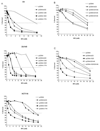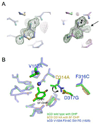Bacterial cytosine deaminase mutants created by molecular engineering show improved 5-fluorocytosine-mediated cell killing in vitro and in vivo
- PMID: 19487291
- PMCID: PMC2765227
- DOI: 10.1158/0008-5472.CAN-09-0615
Bacterial cytosine deaminase mutants created by molecular engineering show improved 5-fluorocytosine-mediated cell killing in vitro and in vivo
Abstract
Cytosine deaminase is used in combination with 5-fluorocytosine as an enzyme-prodrug combination for targeted genetic cancer treatment. This approach is limited by inefficient gene delivery and poor prodrug conversion activities. Previously, we reported individual point mutations within the substrate binding pocket of bacterial cytosine deaminase (bCD) that result in marginal improvements in the ability to sensitize cells to 5-fluorocytosine (5FC). Here, we describe an expanded random mutagenesis and selection experiment that yielded enzyme variants, which provide significant improvement in prodrug sensitization. Three of these mutants were evaluated using enzyme kinetic analyses and then assayed in three cancer cell lines for 5FC sensitization, bystander effects, and formation of 5-fluorouracil metabolites. All variants displayed 18- to 19-fold shifts in substrate preference toward 5FC, a significant reduction in IC(50) values and improved bystander effect compared with wild-type bCD. In a xenograft tumor model, the best enzyme mutant was shown to prevent tumor growth at much lower doses of 5FC than is observed when tumor cells express wild-type bCD. Crystallographic analyses of this construct show the basis for improved activity toward 5FC, and also how two different mutagenesis strategies yield closely related but mutually exclusive mutations that each result in a significant alteration of enzyme specificity.
Figures





Similar articles
-
Comparative analysis of enzyme and pathway engineering strategies for 5FC-mediated suicide gene therapy applications.Cancer Gene Ther. 2011 Aug;18(8):533-42. doi: 10.1038/cgt.2011.6. Epub 2011 Mar 11. Cancer Gene Ther. 2011. PMID: 21394105 Free PMC article.
-
Molecular chemotherapy of pancreatic cancer using novel mutant bacterial cytosine deaminase gene.Mol Cancer Ther. 2008 Sep;7(9):2845-54. doi: 10.1158/1535-7163.MCT-08-0347. Mol Cancer Ther. 2008. PMID: 18790765
-
Yeast cytosine deaminase mutants with increased thermostability impart sensitivity to 5-fluorocytosine.J Mol Biol. 2008 Mar 28;377(3):854-69. doi: 10.1016/j.jmb.2008.01.002. Epub 2008 Jan 11. J Mol Biol. 2008. PMID: 18291415 Free PMC article.
-
Escherichia coli cytosine deaminase: Structural and biotechnological aspects.Biotechnol Appl Biochem. 2024 Feb;71(1):5-16. doi: 10.1002/bab.2516. Epub 2023 Sep 24. Biotechnol Appl Biochem. 2024. PMID: 37743549 Review.
-
Bystander or no bystander for gene directed enzyme prodrug therapy.Molecules. 2009 Nov 10;14(11):4517-45. doi: 10.3390/molecules14114517. Molecules. 2009. PMID: 19924084 Free PMC article. Review.
Cited by
-
The bad and the good of mesenchymal stem cells in cancer: Boosters of tumor growth and vehicles for targeted delivery of anticancer agents.World J Stem Cells. 2010 Feb 26;2(1):5-12. doi: 10.4252/wjsc.v2.i1.5. World J Stem Cells. 2010. PMID: 21607110 Free PMC article.
-
Monitoring enzyme activity using a diamagnetic chemical exchange saturation transfer magnetic resonance imaging contrast agent.J Am Chem Soc. 2011 Oct 19;133(41):16326-9. doi: 10.1021/ja204701x. Epub 2011 Sep 23. J Am Chem Soc. 2011. PMID: 21919523 Free PMC article.
-
Magnetic nanoparticle hyperthermia induced cytosine deaminase expression in microencapsulated E. coli for enzyme-prodrug therapy.J Biotechnol. 2015 Jun 10;203:32-40. doi: 10.1016/j.jbiotec.2015.03.008. Epub 2015 Mar 25. J Biotechnol. 2015. PMID: 25820125 Free PMC article.
-
Bacteria in Cancer Therapeutics: A Framework for Effective Therapeutic Bacterial Screening and Identification.J Cancer. 2019 Apr 21;10(8):1781-1793. doi: 10.7150/jca.31699. eCollection 2019. J Cancer. 2019. PMID: 31205534 Free PMC article. Review.
-
Cytotoxic effect of co-expression of human hepatitis A virus 3C protease and bifunctional suicide protein FCU1 genes in a bicistronic vector.Mol Biol Rep. 2017 Aug;44(4):323-332. doi: 10.1007/s11033-017-4113-4. Epub 2017 Jul 26. Mol Biol Rep. 2017. PMID: 28748410
References
-
- Nishiyama T, Kawamura Y, Kawamoto K, et al. Antineoplastic effects in rats of 5-Fluorocytosine in combination with cytosine deaminase capsules. Cancer Res. 1985;45:1753–1761. - PubMed
-
- Katsuragi T, Sakai T, Tonomura K. Implantable enzyme capsules for cancer chemotherapy from bakers' yeast cytosine deaminase immobilized on epoxy-acrylic resin and urethane prepolymer. Appl Biochem Biotechnol. 1987;16:61–69. - PubMed
-
- Springer CJ, Niculescu-Duvaz I. Gene-directed enzyme prodrug therapy (GDEPT): choice of prodrugs. Adv Drug Deliv Rev. 1996;22:351–364. - PubMed
-
- Austin EA, Huber BE. A first step in the development of gene therapy for colorectal carcinoma: cloning, sequencing, and expression of Escherichia coli cytosine deaminase. Mol Pharmacol. 1993;43:380–387. - PubMed
Publication types
MeSH terms
Substances
Grants and funding
LinkOut - more resources
Full Text Sources
Other Literature Sources
Molecular Biology Databases

